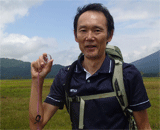September 2022
Risk Management in Uncertain Environments: A Discussion With Professor Murakoshi From Shizuoka University
Risk Management of Bears
Ohsato: Being a researcher, you probably make decisions by taking all the risks into account, but I think most of the general public would have a hard time doing so.
Murakoshi: I definitely don't know all the risks. But making sure to look at things from certain perspectives goes a long way. I always ask myself, "Will the risk change?" and when it does, "How can I control it?" Using just those two perspectives will likely change how you think about risk a lot. For example, with COVID-19, we were told to avoid the 3 Cs (closed spaces, crowds, close contact) from early on. In other words, we clearly knew the factors that increased risk. I wasn't able to personally verify them, but they made sense considering the characteristics of infectious diseases. I didn't feel safe by any means, but since I understood what I needed to do to minimize the risks, I wasn't overwhelmed by fear. Another example is the risk of getting heatstroke in the mountains during the summer. Heatstroke doesn't happen suddenly. Your condition changes gradually. This change is relatively easy to follow, so as long as you have the right knowledge and tools, you can prevent heatstroke. That's why I'm not particularly afraid of it. On the contrary, the risk of lighting changes instantaneously. No matter how much of a nature expert you are, you can't do anything about it.
By the way, have you ever encountered a bear in the mountains?
Ohsato: I have, in Jasper, Canada. It was when I was taking a walk early in the morning. I feared for my life at that moment. Your mind goes blank when you're really afraid, doesn't it? Since I hadn't told my colleagues where I was going, I thought, "No one's going to know if I get seriously hurt out here."
Murakoshi: I see. That may have been a type of calm. Most people are afraid of bears. That's probably because bears can appear out of nowhere in the mountains. And since they're animals, the risk is hard to control. But I personally know that it can be controlled, so I'm not really afraid--at least if it's the Asian black bear, which lives on Japan's main island.
Ohsato: How do you control the risk?
Murakoshi: For example, when I'm walking into places with bad visibility in the mountains, I raise my voice as I go. If you feel an animal's presence or you're in an area where it's not unusual to come across animals, you can control the risk in this way. Even if I were to run into a bear, I know what to do, so if it's an Asian black bear, I know I can likely control the risk. Black grizzly bears that live in Hokkaido, on the other hand, are frightening.
Ohsato: That's probably because you have a higher risk awareness than most people. I think I would simply be consumed by fear and unable to even think about whether I can control the risk.
Murakoshi: But I think that's a good entryway into the right kind of thinking. It's normal to first experience fear when you encounter danger, which makes your thinking vague. I feel that being able to ask yourself the concrete question of "Can I control this?" at that moment allows you to take a step forward. I've been participating in the activities of an Antarctic research team since 2016, and I once traveled to Antarctica to conduct interviews. Not surprisingly, fear is at the forefront of everyone's minds at first. But they soon begin to respond logically through experience and by thinking about the characteristics of the risks. Without the fear, they would die before being able to respond logically.
I once ran into a bear too during an orienteering training camp. Like you, the moment I came face to face with it, I grew so scared I stopped thinking. I knew I shouldn't run away, but my legs moved on their own. Bears have a habit of chasing after prey that run away, so running is the worst thing you can do. If you run, they'll definitely chase you. And bears can run extremely fast.
Even though I knew all that, I still ended up running away as fast as I could. I knew it would catch up quickly, but I couldn't make myself stop. Just then, for better or worse, I fell down hard. That surprised the bear too, and it stopped. It was about two meters away from me. I suddenly grew very calm at that moment. I thought, "I don't want to be beaten one-sidedly like this" and managed to recall where a bear's vital points are and what I needed to do. I glared at the bear and after about three seconds, it backed off.
Ohsato: I'm glad. If we hadn't both successfully fended off bears in the past, we wouldn't be sitting here talking right now (laughs).
Wanting to Nurture Risk Management Experts
Ito: As someone engaged in this sort of research, what are you looking for in translations?
Murakoshi: The contents of my research haven't all become knowledge that is shared throughout the world. When I think about that, I feel the need to convey this research to the world. The only way to do that is in English. Recently, I keep coming back to the reality that research papers written in Japanese are only cited by a handful of people. But the number of citations skyrockets when the paper is written in English.
One aspect of my research field involves organizing jumbled concepts. For example, when I explain my research topic to others, I use the word "risk." But I often question whether the essence of the phenomenon I want to research can really be described as "risk" and feel that it should be expressed a little differently. In such cases, you need to create the concept itself. It's not enough to simply submit a research paper to a translation company and have them proofread and revise it. With Arc Communications, I can discuss things like whether a certain English word appropriately describes the Japanese concept. I think many researchers want to have these sorts of discussions.
Ito: Our linguist once came up with three potential translations for a Japanese word with a broad meaning. For each one, the linguist gave a detailed explanation on which part of the Japanese text it emphasized most and which part it fell short of expressing, and this allowed us to have a discussion. When we came to a conclusion on the most appropriate translation through this process, we were very happy to have been of use.
Ohsato: Lastly, please tells us about your future aspirations.
Murakoshi: I spent about three years creating a program to teach navigation techniques in Japan, and it's training the next generation. I've also succeeded in monetizing it. Next, I want to nurture experts who can manage risks using the methods I spoke about today.
Instead of focusing on fields like corporate risk management, which has already been thoroughly researched, I want to focus on nature activities and school education, where risk management has not been e taken into consideration enough until now. I want to nurture people who can use the ideas that I talked about to not be overly afraid of risk and maintain balance as they engage in risk management and consulting. The world today is described as a risk society, and guardians of school children have such a heightened awareness of risk to the point of being excessive. Of course, we need to be afraid of risks to protect children. But that alone won't allow children to grow, and more than anything, they won't be able to learn how to protect themselves from risks.
Ohsato: As Arc Communications, we hope to continue supporting your success in the future. Thank you for taking the time to talk to us today.
-------------------------
Need help with a translation or interpreting project? Feel free to contact us here.
Arc Communications
Feature Interview Index

















